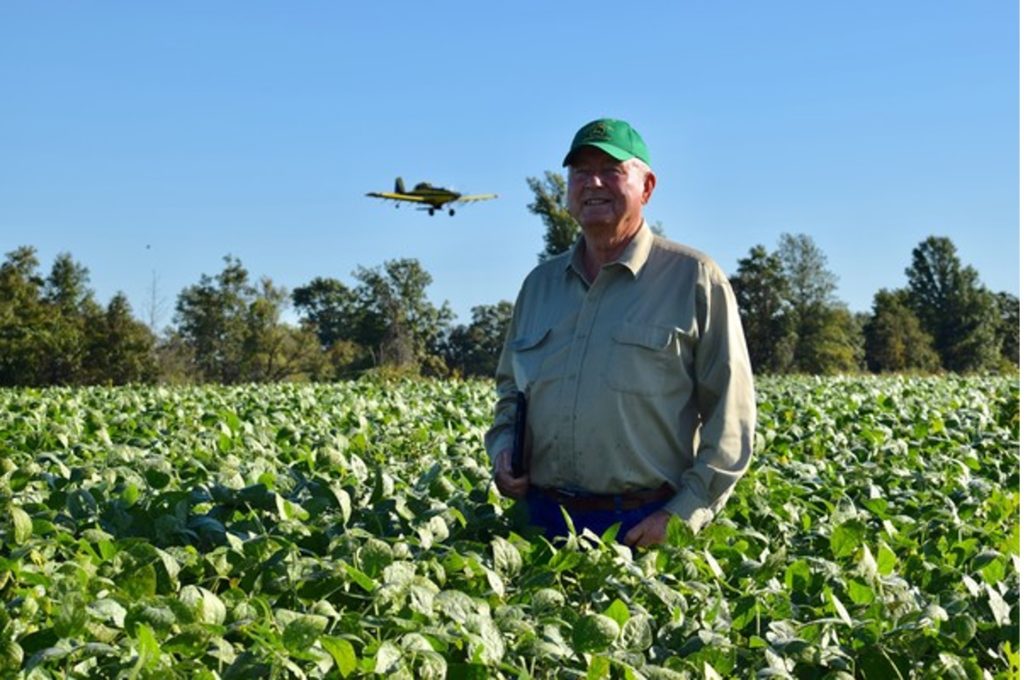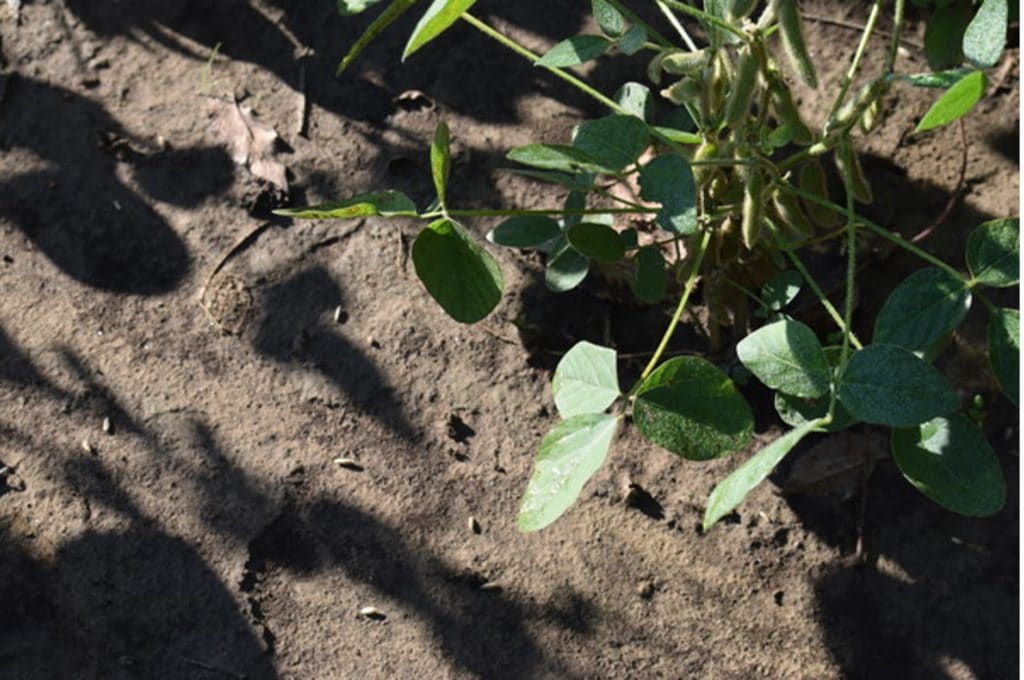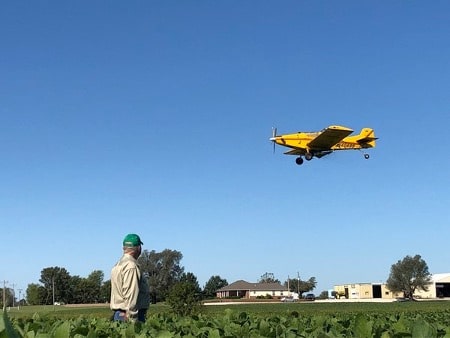Farmer uses aerial approach to planting cover crops
SOUTH COFFEYVILLE, Okla. – Torrential rains fell in May and radish, turnip and cereal rye seeds fell in October over Scotty Herriman’s farm.

Recently Herriman stood in his soybean field about a half mile from the Verdigris River in northeastern Oklahoma as an airplane buzzed over top, about 40 feet up, dropping a cover crop mix of radishes, turnips and cereal rye upon the beans and the 70-year-old producer
Where he stood on this day was about 8 feet under water in May. His corn, knee high before the rains, was gone. Portions of some stalks, a few cobs and even the shell of a native mussel were about all that was left. However, he’d made a commitment back in March or April through the United States Department of Agriculture (USDA) Natural Resources Conservation Service (NRCS) Environmental Quality Incentives Program to plant cover crops, and his window of opportunity had just about shut and locked. He had drilled the cover crop seed on about 80 acres of already harvested upland corn, but with time of the essence, he called a flying service from nearby Miami, Okla., so that he could fly the seed in on about 480 acres of the beans.
Herriman has been farming on this particular farm for over 50 years.
In his office is a framed collage of family photos, some in black and white and others in color. Among the black and white prints is a photo of his grandfather as a child in Arkansas and another of his father at age 16 holding the reins on two “big old mules.”
As Herriman watched a plane go over head, he talked about then and now.
“We thought everything had to be plowed and disked, field cultivated, harrowed down … , but when we started no-tilling eight or 10 years ago we could see that it will work,” Herriman said. “Now comes the flying part of it. I truly believe it will work. Yes the difference was that none of this could have happened that long ago, but we know that you can over seed crops in ground that hasn’t been tilled and it does work.”
Herriman paused, then said, “I wish my grandpa (W.J. Herriman) and my dad (Odis Herriman) were standing here beside me because they would say, ‘Son you’re crazy. You are absolutely crazy.’ To me, it’s time to do this. I do wish they could be here. I wish they could ride on the combine with me, I wish they could do a lot with me, because they would say, ‘Wow, what is this son?’”
He grew up here in Nowata County near South Coffeyville, Okla. He respects what he was taught, and he’s never lost the willingness to learn and consider new ways.
“It’s kind of a new day for us in cover crops, but since the soil health initiative has taken place, it’s spurring me on to try some of these new things,” said Herriman, who was inducted into the Oklahoma Conservation Hall of Fame in 2012 and serves as the Area III Commissioner of the Oklahoma Conservation Commission. “Hopefully it will work here in this old black soil bottoms and we can pass that information on to others across the state, and maybe others will try it and we can spread this good news about cover crops.”
How this came to be

In the spring, Herriman signed up for the Environmental Quality Incentives Program (EQIP) that promoted cover crop adoption because he was going to have 650 acres of corn.
“It was going to be in the bottoms and prairie too,” Herriman said. “So it was going to be an easy thing for me to drill cover crops behind the corn in early September. Well, here comes the flood in May. The corn was knee high and we lose it all.”
In most places water was standing 6 to 9 feet deep and in the draw up to 18 feet deep during an 11-day stretch in this area that is less than five miles from the Oklahoma-Kansas state line.
Farmers and ranchers often use up most of the alphabet in planning. In other words, plan A is seldom the final plan. Herriman and so many other farmers found themselves in that situation after the massive floods in May and some floods that preceded or followed.
“Well we had to go to soybeans to have a crop,” he said. “The light came on, ‘I signed up for a program for cover crops. Now I’ve got beans and they’re not going to come off until nearly frost because they were late going in.’ So I got the idea I could fly in this cover crop and still maintain my agreement with NRCS to get these planted. The program I signed up for in the spring was to break compaction in the soil.”
At that point he had to find a “flier to fly them on.”
“When the color of the soybean leaves start to turn yellow, they are going to be dropping in about a week to 10 days,” he said. “So, we need to fly the cover crop seeds on when the soybean leaves are yellow. The leaves drop off, cover the seed up, and here comes the cover crop of turnips, radishes and cereal rye.”
Herriman was asked to explain in a little more detail how this dropping the seed as opposed to drilling it, works.

“If you would try cereal rye by throwing it out on your gravel driveway, along with rain, you are going to get a stand,” he said. “On the radishes and the turnips, they recommend a quarter-inch deep when you are drilling. It’s hard to set a drill for a quarter of an inch. However, in the beans where we are flying it on, the leaf canopy from the soybeans is going to come down on top of that seed and that is going to be that quarter of an inch. Once we get a rain, it will start germinating and coming through.”
As for the soybeans, “The beans will be dried and mature and we’ll start harvesting those beans in about two to three weeks.”
Out of the clear blue sky
Herriman called Midland Flyers, based out of Miami, Okla., and on Oct. 8, on a clear, calm fall morning, two planes arrived at Herriman’s farm and went to work with precision seeding. In separate fields, they would fly from north to south then curl around and seed back the other way.
The seeds tapped the leaves of the heavily dew-covered soybeans. Most of the seed made its way to the ground immediately and the remainder got there with the help of a breeze that picked up around mid-day.
Within two and a half hours they had seeded 472 acres, and that time span included a trip for each back to Miami to load back up with seed. Herriman’s 25-pound cover crop mix consists of 2 pounds of turnips, 3 pounds of radishes and 20 pounds of cereal rye.
The pilots from Midland Flyers were Randy Wyrick and Zach Lawson, who have done this in other states.
At Herriman’s farm, Wyrick was flying an Air Tractor 802 hauling 4,990 pounds of seed, and Lawson was flying a Thrush 550, hauling 3,300 pounds of seed.
“The idea of 20 pounds of cereal rye, instead of 40 or 50, is to allow more sunshine for the turnips and radishes to grow as they should and not be overburdened with shade,” Herriman said.
So where did he come up with the idea of flying in the cover crop seed?
“Flying like this is not new to other states. It’s fairly new maybe to Oklahoma,” he said, “but I know Missouri, Indiana and Illinois, they fly on cover crops into standing corn fields for instance. When they get the corn harvested, the cover crops are flourishing quite well. It was not my choice. I would rather drill all this, but due to the flood causing the beans to be later, we had to go ahead and fly and get it coming up as the leaves start changing. I think it’s going to be beneficial.”
Herriman said he could plant the cereal rye even in November and probably still be good, but with “our deep-rooted radishes and turnips, time is of the essence right now. We had to do this as the planes were available, and the weather permitted.”
“The only way I would have done this and could have done this is with the help of NRCS,” Herriman said.
“Their EQIP Program that promotes the use of cover crops, allows us the opportunity to get federal monies to try some of these things. With that three-year contract that I’m in, that’s exactly what we’re doing. We’re making it happen.”
Hope remains
This year wasn’t the first time, or even the second that Herriman had seen floods come through.
One major example came in 2007. Historic flooding to the north in southeast Kansas sent massive amounts of water into Oklahoma. Herriman had experienced floods in the 1970s and 1980s, but this one was 5 feet higher than the others. It destroyed their mobile home and left straw in some power lines. The Herriman family harvested 13 acres of wheat. That’s all that was left.
Herriman is quick to point out that the floods wash away crops, but not hope and faith.
“We’ve been down this path numerous times on this river, so you kind of get accustomed to the fact that it’s going to happen,” he said. “You never like it. You never enjoy it, but there is hope when you can see new crops, and you can come back. It keeps us alive and looking forward.”
As he looked down at the cover crop seed dropped minutes earlier, Herriman got a smile on his face. A familiar saying had come to mind, “My dad always said, ‘The seed won’t grow in the bag. You have to plant it.’”
So they did, from roughly 40 feet in the air.
